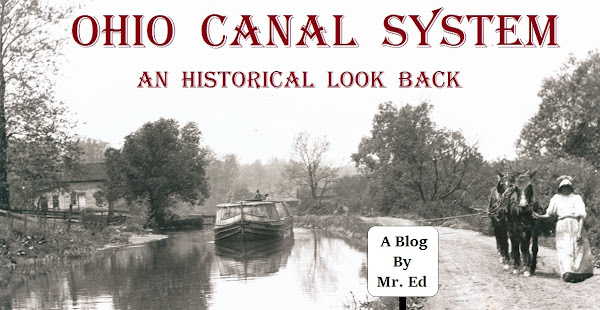From Wikipedia, the free encyclopedia
The Ohio and Erie Canal was a canal constructed in the 1820s and early 1830s in the U.S. state of Ohio. It connected Akron, Summit County, with the Cuyahoga River near its mouth on Lake Erie in Cleveland, Cuyahoga County, and a few years later, with the Ohio River near Portsmouth, Scioto County, and then connections to other canal systems in Pennsylvania.
The canal carried freight traffic from 1827 to 1861, when the arrival of railroads killed the market. From 1862 to 1913, the canal served as a water source to industries and towns. In 1913, much of the canal system was abandoned after important parts were severely flooded.
Today, most of the remaining portions are managed by the National Park Service or Ohio Department of Natural Resources. They are used for various recreational purposes by the public, and still provide water for some industries. Parts of the canal are preserved, including the Ohio and Erie Canal Historic District, a National Historic Landmark.
To Read More: Go to the Wikipedia site...
https://en.wikipedia.org/wiki/Ohio_and_Erie_Canal
-
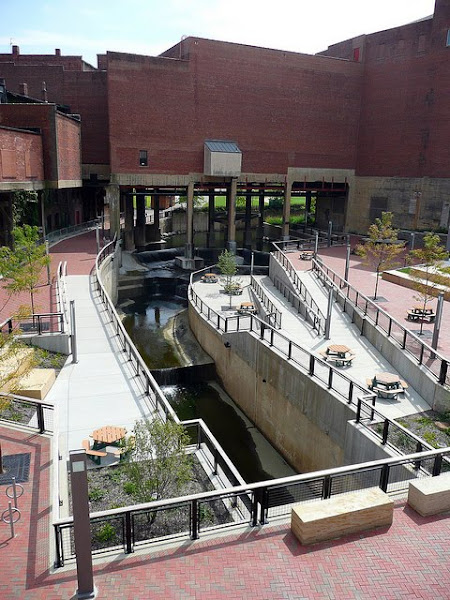
Looking at the Canal system today in downtown Akron, Ohio, it appears to be a nice little creek running through and around the buildings. But there was a time when the city, like so many others, depended on this little creek to supply them with the goods that were needed for the citizen's everyday life. Before the airlines, before the railroad, there was the canal.
-
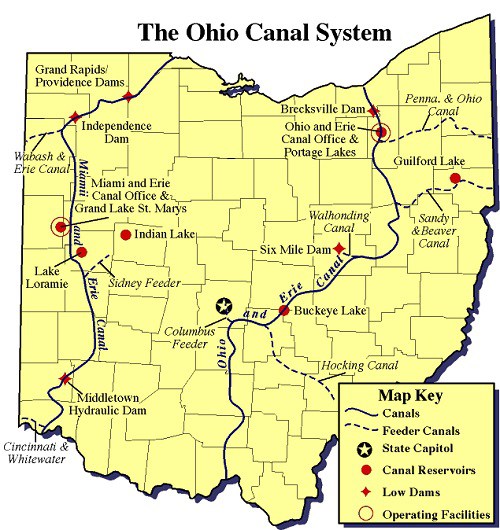
-
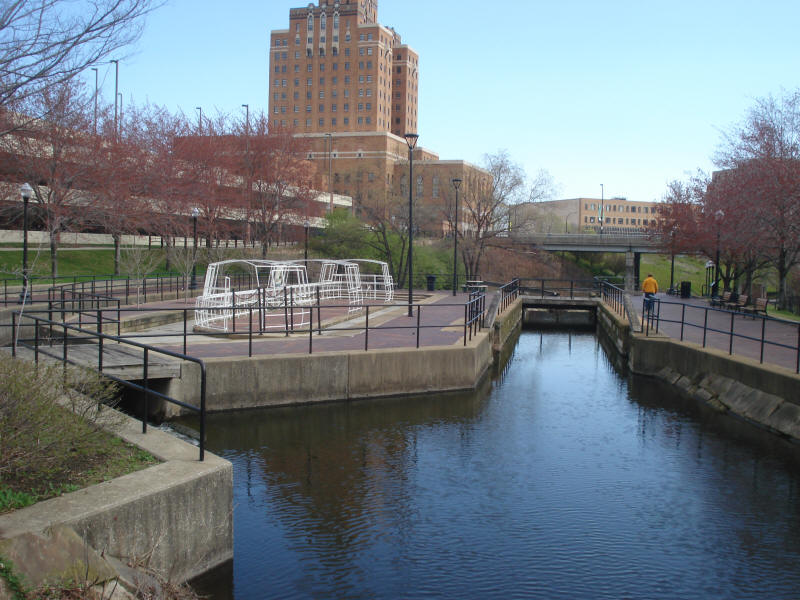
For the people in the 1820s, '30s, '40s and '50s, the canal was one of the most important highways through the state. Everything was shipped by means of the canal. Food, medicines, clothing, firearms, lumber, tobacco, fancy furniture, etc.It was the internet of it's time.
-
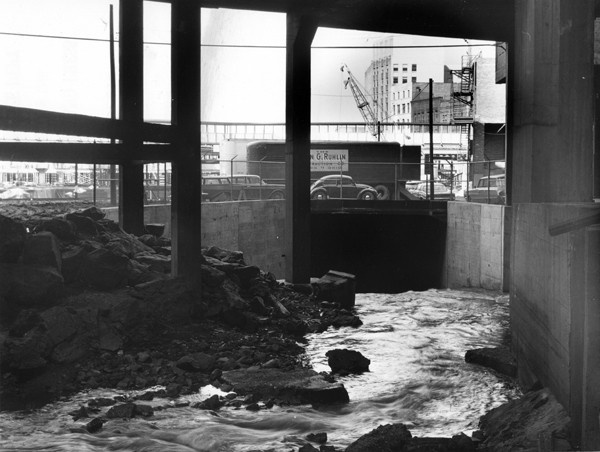
If you needed something such as a musical organ, a wood-burning stove or some wire fencing, you would head to the store. If they didn't have what you needed, they would order it from some company in New York, Chicago or Atlanta. And in three to six weeks, you had what you needed. That's right! Three to six weeks, or maybe ten weeks, it would depend on several factors. In those days there was no UPS, no overnight air deliveries, not even a railroad in those earlier days. Everything came by wagon over the mountains and through the woods, or it came via the canal system.
~1870s ~
'Spring in 1877' Canal Mural of the Mustill store.
~ 1880s ~
Canal, Bolivar, Ohio. 1880s.
-
Canal Boat. Early 1880s.
-
Canal Feeder Lock 1881.
-
Canal boat operated by J.C. Kellogg, 1882.
-
Joe Prieter's Rubber Stamp and Sign business on the Ohio & Erie Canal in Bolivar, Ohio. In the distance is the Bolivar Aqueduct. 1888.
~ 1890s ~
Canal Boat Living 1890s.
-
1890s. A canal bridge in Adams Mills, Ohio. The village of Adams Mills is located a few miles north of Dresden, Ohio. Adams Mills was settled by employees of the George Willison Adams and Edward Adams Flour Mill, which was built on the Ohio and Erie Canal. In the early 1900s, the mill was moved to Dresden, Ohio where it still stands.
-
Canals - C. Harris Coal Co. 1890.
-
Captain Pearl R. Nye, Canal boat operator, 1890s.
-
The Canal Boat Cemetery in the Upper Basin of the Ohio & Erie Canal near Falor Street in Akron, Ohio.
-
1890s.The Diamond Rubber Company on the Ohio & Erie Canal in Akron, Ohio. O. C. Barber, president of the Diamond Match Company and founder of the city of Barberton, established The Diamond Rubber Company in 1894 under the name The Sherbondy Rubber Co. In 1896, the name was changed to the Diamond Rubber Company when it began the manufacture of automobile tires. The Diamond Rubber Company was eventually merged with B.F. Goodrich in 1912.
-
Men Fishing from a canal wall. 1890.
-
A picnic gathering on a canal boat. 1890.
-
Ohio and Erie Canal behind S. Main St. in Akron. Men on canal boat, ca.1890.
-
1892. Two boys standing on railroad tracks next to the Ohio & Erie Canal near Summit Lake in Akron, Ohio. B.F. Goodrich Company can be seen in the background. The Ohio & Erie canal was eventually replaced by the railroad.
-
1898. Two men and two women on top of the "Maggie Case" canal boat near a mule / pedestrian bridge on the Ohio & Erie Canal in Akron, Ohio. Canal boat captains preferred mules to horses because of their unique hybrid characteristics. From the donkey (the father), mules get intelligence and small hooves, which results in sure-footedness. From the horse (mother), mules get a cooperative disposition, endurance and strength.
~ 1900 ~
1900. Akron. A man stands on a raft near a retired canal boat that was converted into a house (D.T. Wonn Houseboat). The "house boats" were located behind residences on South Main Street, near Wooster Avenue, and behind the B.F. Goodrich building.
-
Boat House and Row Boats 1900.
-
Boat House and Row Boat 1900.
-
Canal by the B.F. Goodrich Rubber Company, 1900.
-
Boys in a rowboat on the canal. 1900.
~ 1901 ~
1901. A man fishing at Lock 19 on the Ohio & Erie Canal. Lock 19 is currently located underneath Memorial Parkway in Akron.
-
1901. The Moody Thomas Milling Company along the Ohio & Erie Canal in Peninsula, Ohio.
-
1901. An unidentified man standing along the Ohio & Erie Canal at Casade Locks (Lock 15 pictured) in Akron, Ohio. To the right is Mustill Store. The Mustill Store is one of the oldest surviving buildings in Akron. Built between 1825-1850, the store served canal travelers on the Ohio and Erie Canal.
-
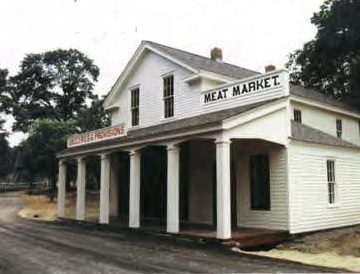
The Historic Mustill Store as it appears today after it's restoration. Originally, the store catered to the canal boats. The boats brought needed supplies and stock to the store and the store sold goods to the canal captains, crews and passengers. So it was a win-win situation for all parties. The store was, and still is, located right on Lock 15.
~ 1906 ~
The Ohio River circa 1906. Canal locks at Louisville, Kentucky.
-
The last canal boat to be launched on the Ohio & Erie Canal from Akron, Ohio. The boat was built by W.J. Payne Ship Yard near Lock 2 at West Buchtel Avenue and Water Street. The boat was owned and operated by the State (State Repair Boat #2), and was used for canal maintenance until the flood of 1913. It was 80 feet long and 14 feet wide.
~ 1908 ~
Boy walking horse along the canal. 1908. The boats were pulled by mules or horses. There was a "towpath" beside the canal banks and someone would guide the animals pulling the boats with a long rope. The "drivers" of the animals would be men, women or young boys.
~ 1910 ~
Canal Lock and Mill circa 1910.
-
1910. A river lock at the end of the Ohio & Erie Canal in Cleveland, Ohio. The area was known as the "Dog Pond."
~ 1913 ~ The Great Ohio Flood of 1913
A century ago, hurricane force winds, blizzards, and tornadoes preceded the days of the Great Flood of March 1913. And then, when the rains came - pouring down two to three months worth of rain from March 23rd through March 27th - every river in the State of Ohio overflowed its banks. In a flood whose impact would be bigger than current landmark weather events such as Katrina and Sandy - the impact on life in Ohio and 14 other states was overwhelming.
The Flood of 1913 also would bring an end to the Ohio & Erie Canal.
To Read More of the flood of 1913, go to this website:
http://ohioanderiecanalway.com/Main/Pages/The_Great_Flood_of_1913_106.aspx
The End of Canal Use ~
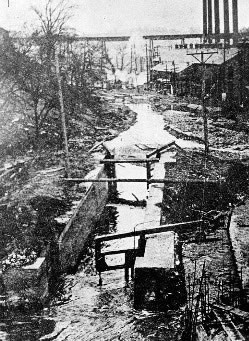
Akron Canal Locks after the 1913 Flood.
-
Canal in downtown Akron 1913.
-

Lock at the Mustill Store is shown above right after the 1913 flood. Several of the canal locks had to be blown up with explosives to allow the flood waters to resead.
-
Ohio Canal lift bridge in Massillon, Ohio destroyed by the flood.
-

Mustill store after the flood waters went down.
~ 1914 ~
Another picture of Captain Nye taken in 1914 in Akron.
~ 1920s ~
The canal at Bowery St. 1920s.
-
The canal in the snow circa 1925.
